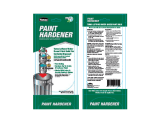
BONDO WOOD FILLER
Directions for Use
1. Clean surface with warm, soapy water or a surface cleaner to remove dirt, wax, oil and grease. Allow to dry.
2. Sand the surface with 3M™ Sandpaper 80 grit to remove all primer, paint, loose rotted wood or rust extending one to
two inches beyond the damaged area. Remove all dust created from sanding. Re-clean the surface following Step #1.
Optional: If repairing rotted wood, first use the Bondo® Rotted Wood Restoration to re-harden the wood and create a hard
base before filling.
3. Remove a 3-inch diameter circle, 1/2 inch thick of the Bondo® Wood Filler and place on a clean non-porous mixing
surface. Knead the Bondo® Red Cream Hardener tube thoroughly to ensure contents are well mixed. Squeeze a 3-inch
strip/bead of red cream hardener across the filler that you removed from the can. Note that the total working time after you
have mixed the filler and hardener will be 3-5 minutes at 75°F (24° C). Mix only small amounts that can be used within the
total working time.
4. Thoroughly mix for approximately 2 minutes to uniform light red color using the Bondo® Spreader. Mix the filler and
hardener, keeping the contents thinly spread out will keep the filler from curing as quickly and give you a longer working
time
5. Spread initial thin layer of mixed filler over repair area using firm pressure to ensure maximum adhesion. Apply
additional layers until desired thickness is reached. Allow 10 minutes for the filler to dry (20-30 minutes if the room
temperature is cooler than 77 degrees F/25 degrees C)
6. Using 3M™ Sandpaper 80 grit, sand and shape the filled area to the contour of the surface. Feather the edge of the
area with 3M™ Sandpaper 180 grit until the surface is smooth. If dust builds up or clogs the sandpaper, remove by
brushing with wire brush.
7. Prime, paint, or apply wood stain to the area per the manufacture’s recommendation. Note: If staining, test an area is
recommended as the Bondo® Wood Filler absorbs the stain differently than wood.
8. Clean tools with acetone or lacquer thinner.
Read more at http://bondo.com/featured/bondo-wood-filler-30081.html#RtQacRlkmFF30rhd.99

Numerous Applications
Designed for interior and exterior wood repair, Bondo® Wood Filler has your home repairs covered.
Bondo Home Solutions Wood Filler rebuilds, restores and replaces rotted or damaged sections of wood on doors,
windows, fences, furniture, shutters and more. This wood filler is the best choice for repairing any wooden item in or
around your home. Once dried, it can be sanded, shaped, planed, drilled, routed or sawed just like wood. This durable
product is formulated to accept stain and paint more naturally than most wood filler products. For rotted wood problems,
use Bondo Home Solutions Rotted Wood Stabilizer before applying the wood filler.
Common applications or damaged areas include:
Window sills
Furniture
Exterior wood trim such as door frames and jambs, soffits and fascia
Cabinets
Fences and posts
Decks
Garage doors
Wood floors and stairs
Siding
Exterior wood columns, doors and flower boxes Interior doors, baseboards and more
-
 1
1
-
 2
2
3M Bondo® Rotted Wood Restorer User guide
- Type
- User guide
- This manual is also suitable for
Ask a question and I''ll find the answer in the document
Finding information in a document is now easier with AI
Related papers
-
3M 30081 User manual
-
3M Bondo® All-Purpose Putty User guide
-
3M Bondo® Metal Reinforced Filler User guide
-
 Bondo 20122 User guide
Bondo 20122 User guide
-
3M PN31846 User manual
-
3M DI-NOC™ Architectural Finishes WG-410, 4 ft x 164 ft Operating instructions
-
3M DI-NOC™ Architectural Finishes WG-410, 4 ft x 164 ft Operating instructions
-
3M 0928 User guide
-
3M Marine High Strength Repair Filler User guide
Other documents
-
DAP 7079800543 Operating instructions
-
 Homax 2134 Operating instructions
Homax 2134 Operating instructions
-
Aquatic 35RKWH Operating instructions
-
 Bondo 420 User guide
Bondo 420 User guide
-
 J-B Weld 8250-4 User manual
J-B Weld 8250-4 User manual
-
 Dumas 1257 User manual
Dumas 1257 User manual
-
 Top Flight , Inc. Baby Toy MK IX User manual
Top Flight , Inc. Baby Toy MK IX User manual
-
 Hobbico Extra 300S Assembly Instructions Manual
Hobbico Extra 300S Assembly Instructions Manual
-
J-B Weld 40001 User guide
-
 HB&G 701599 Installation guide
HB&G 701599 Installation guide









